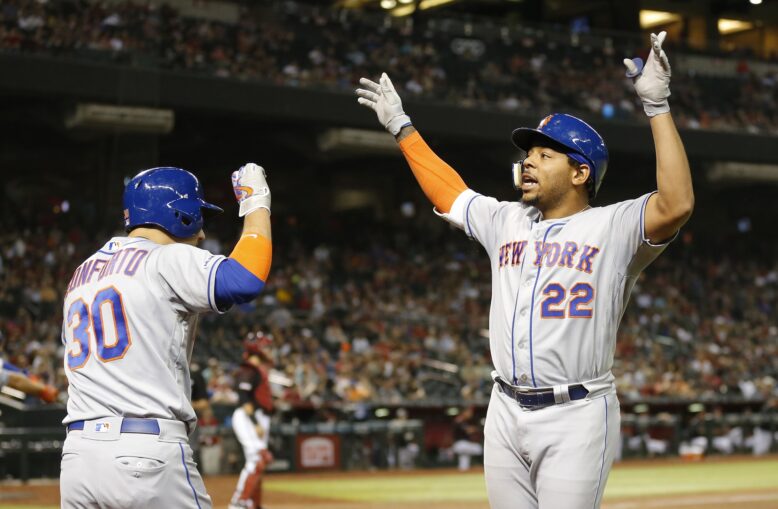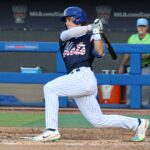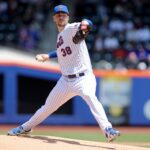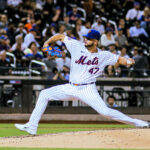
After a 7-1 homestand against the Tigers and Nationals, the Mets failed to live up to expectations on their 2-5 road swing against the Dodgers and Diamondbacks. The Mets’ bullpen continued to struggle mightily, as Edwin Diaz blew a three-run lead in Los Angeles and Jeurys Familia and Robert Gsellman blew a four-run lead in Arizona on Saturday.
Adding to the Mets’ problems, Dominic Smith was scratched from Sunday’s lineup due to a sore thumb. Fortunately, Smith was able to pinch hit last night after a MRI revealed that he had a sprained thumb. If the Mets lost Smith, it would have undoubtedly been a tough blow to the slumping Mets.
Over his last 23 trips to the plate, Smith is hitting .450/.522/.800 with two home runs. Overall, he is batting .359/.461/.563 in 76 plate appearances and has been worth a robust 1.1 fWAR, a substantial improvement upon his first two seasons in the bigs (2017: -0.6 fWAR; 2018: -0.5 fWAR). But he has yet to receive regular playing time given that the Mets have Pete Alonso at first base.
Once Smith is able to return to the starting lineup, one can expect him to receive more reps moving forward, as Callaway is now willing to play Smith in left field. His defense there will surely be a work in progress, but getting Smith’s bat into the lineup more regularly should be a priority for Callaway and company.
Smith’s hard work in the offseason is certainly paying off, as he’s off to an extremely impressive start. In an interview with Kyle Glaser of Baseball America, Smith talked about how he adjusted his stance at the plate:
Less moving parts. I’m a little bit taller now because when I was in my legs I would rock back too far and it would get me out on my front foot, and once I’m out on my front foot I’m trying to catch everything out in front and that’s what causing me to chase a lot of pitches. Now, I’m more tall, so I can really sit on that back hip and really reach and read the pitches now. I’m still really young, it’s crazy. You look at some of the greatest players, you look at (Aaron) Judge, you look at (Mike) Trout—their first couple hundred at-bats wasn’t the best, but they’re some of the best players in the game now. So at 23 years old, I feel like I still have a lot of potential and upside and I worked really hard this offseason, so I’m excited to do what I can in spring.
As can be seen in the images below, Dominic Smith is utilizing a much more subtle leg kick (he’s not trying “to catch everything out in front”) in 2019. He’s also cocking his bat in a more upright stance (presumably to enhance his timing), as well as keeping his hands in a lower position.

Aug 22 2018 (Credit: Baseball Savant)

May 29 2019 (Credit: Baseball Savant)
Additionally, Smith’s plate discipline has improved dramatically this season. After walking only 2.7 percent of the time last season, he is now walking nearly 15 percent of the time, not to mention he’s remarkably lowered his strikeout rate by 12.8 percent (from 31.5 percent to 18.7 percent).
2018
- O-Swing% (percent of the time a hitter swings at pitches outside the strike zone; according to FanGraphs): 39.8
- Swing%: 52.6
- SwStr% (percent of the time a hitter swings and misses): 14.3
2019
- O-Swing%: 30.4 (-9.4)
- Swing%: 45.8 (-6.8)
- SwStr%: 11.5 (-3.8)
Dominic Smith has developed a much more patient approach, which has allowed him to wait for pitches that he can do significant damage to. While I hate to dampen the enthusiasm, Smith’s staggering .435 BABIP entering Tuesday’s game is plain hard evidence of some extreme batted ball luck. Of the 47,239 batters to register at least 70 plate appearances during a single season (1871 – 2019), Smith’s .435 BABIP is the 33rd highest on the list (he’s in the 99.9 percentile!). Often times, line drive hitters run higher BABIP than their peers. But in taking a closer look at Dominic Smith’s batted ball profile, he does not appear to fall under that category.
- League average line drive percentage: 21.2
- Dominic Smith’s line drive percentage: 20.4
His career high batting average on balls in play is .380, and that was in 2017 when he was playing at triple-A. Smith’s BABIP has not exceeded .315 since then. To determine what Dominic Smith’s batting average may look like the rest of the way out, we’ll calculate a weighted average of his BABIP from his first three seasons in the majors:
Weighted BABIP: (2017 BABIP [.218] * 0.25) + (2018 BABIP [.297] * 0.35] + (2019 BABIP [.435] * 0.4) = .332
Based on this weighted average, Smith’s batting average moving forward will likely hover around the .270 range (.332 * 51 batted ball events = 16.932 hits; 16.932 / 63 at-bats = .269), which is still a valuable hitter.
Ultimately, Dominic Smith has reinvented his game through implementing a new stance and a more patient approach, and he looks to provide a jolt to the Mets offense in the coming weeks.















